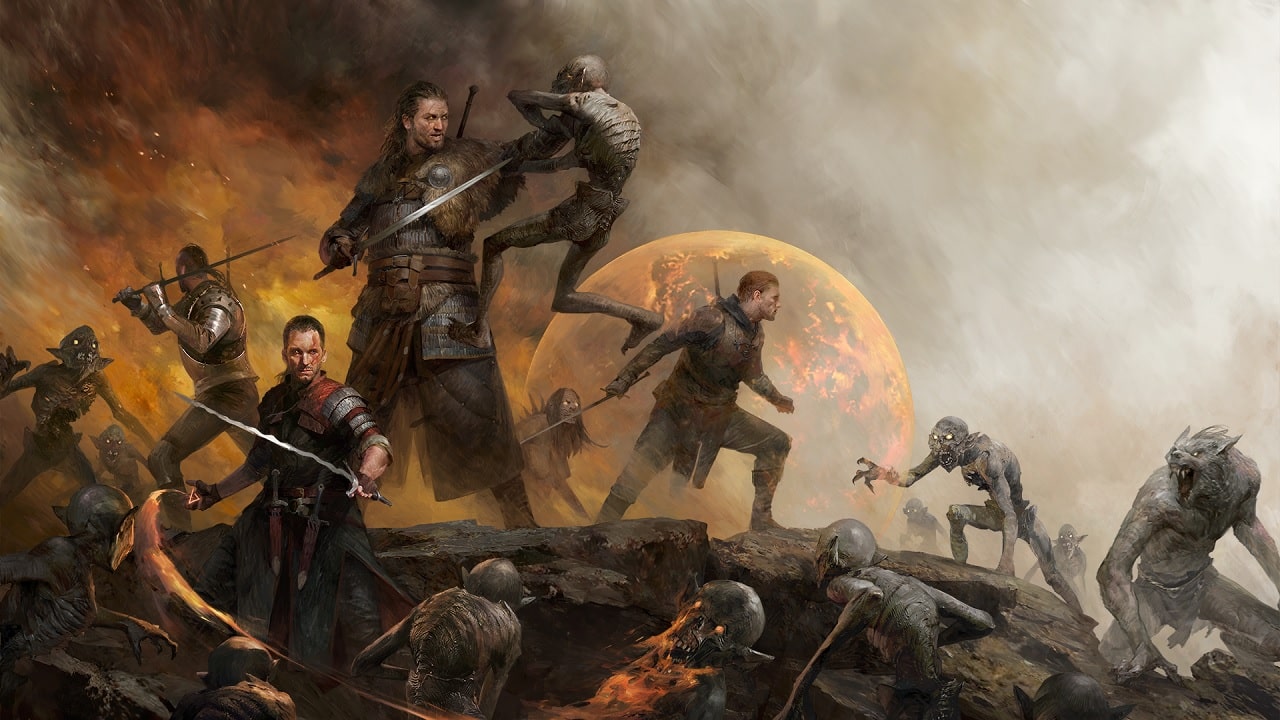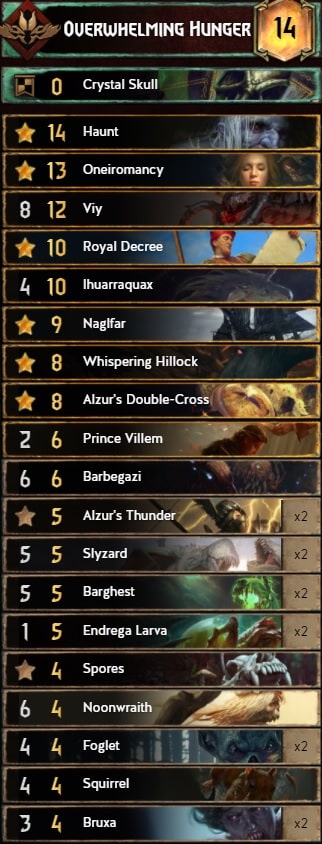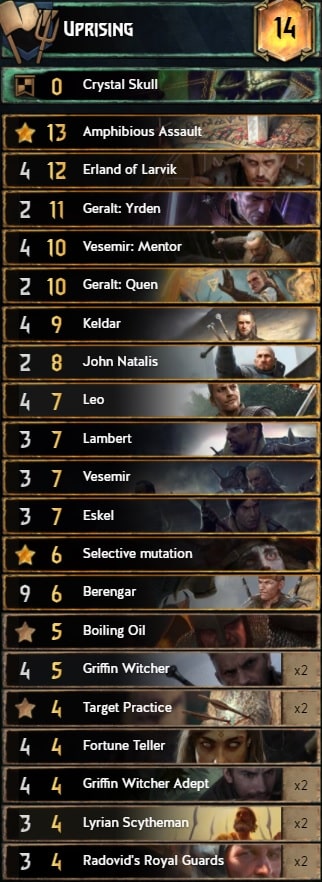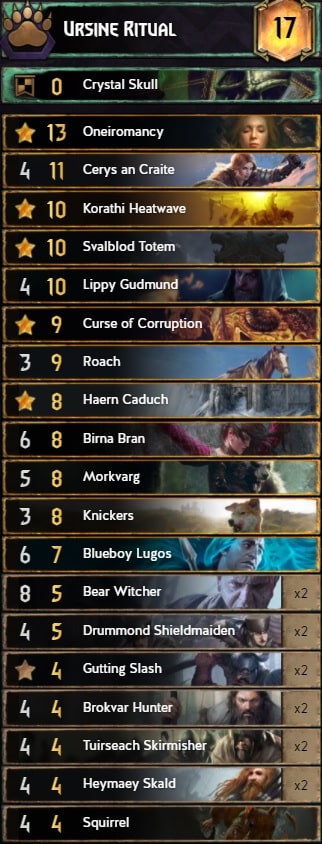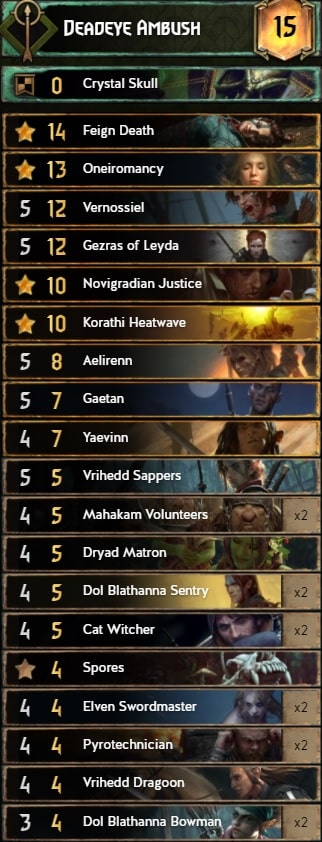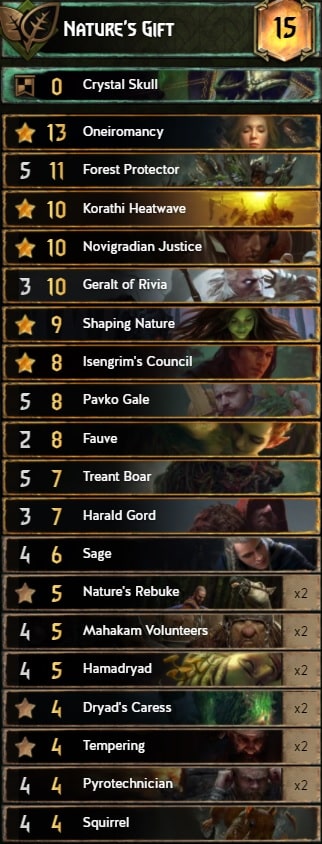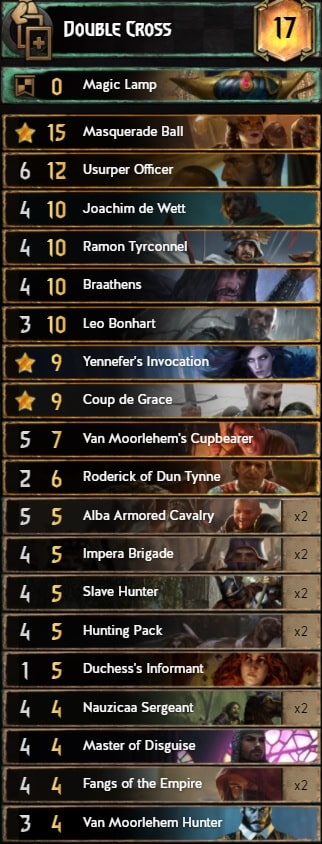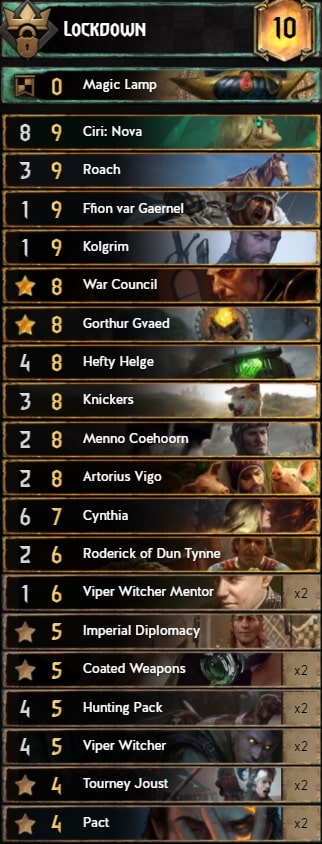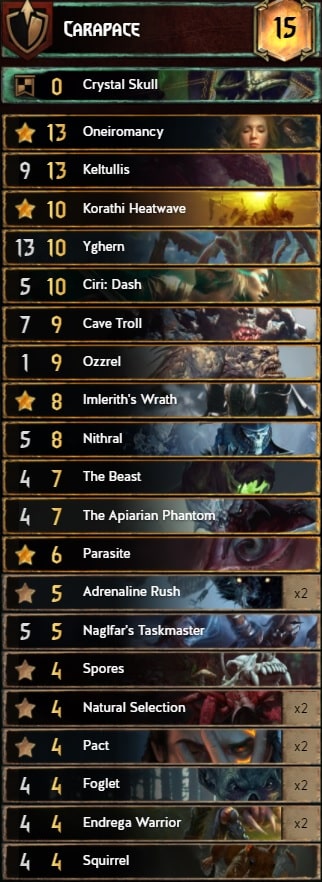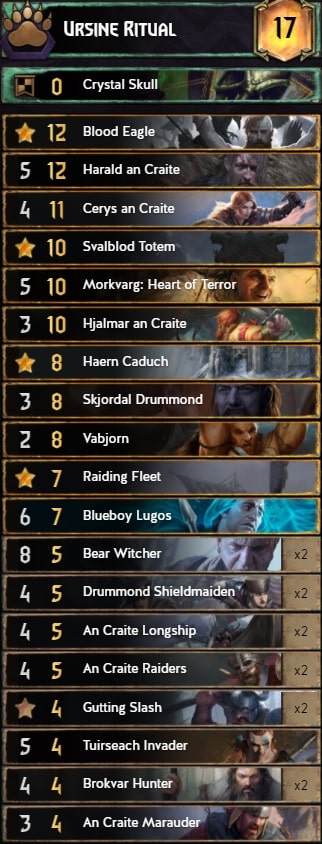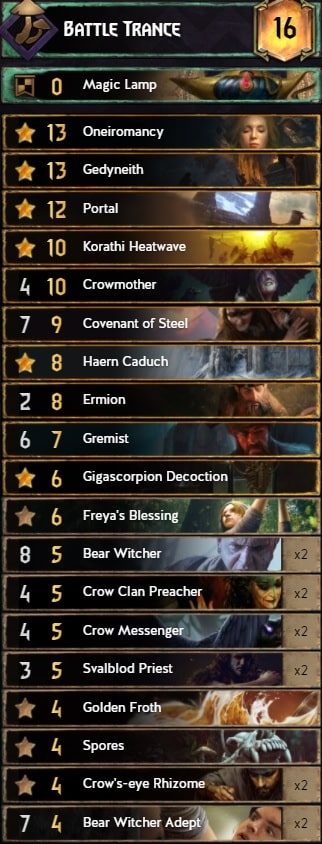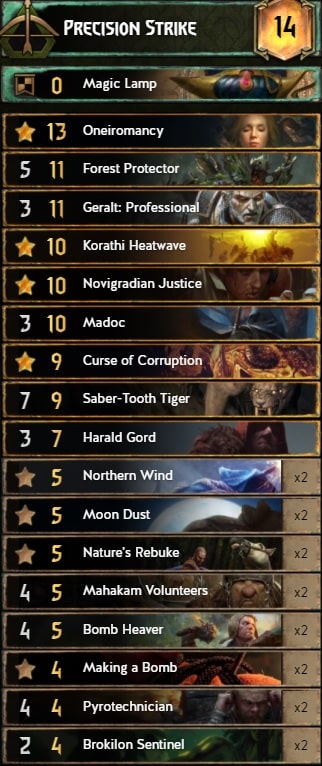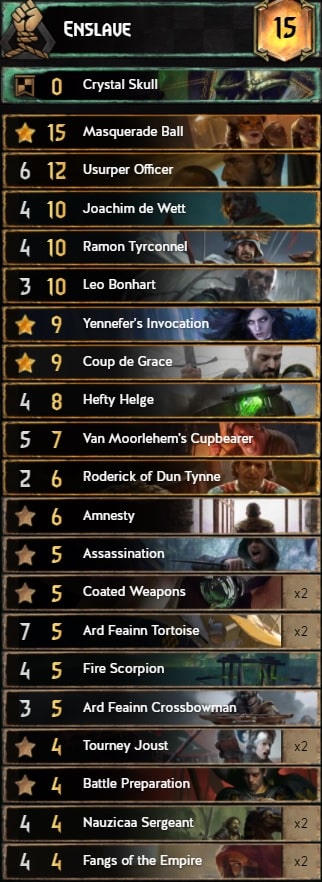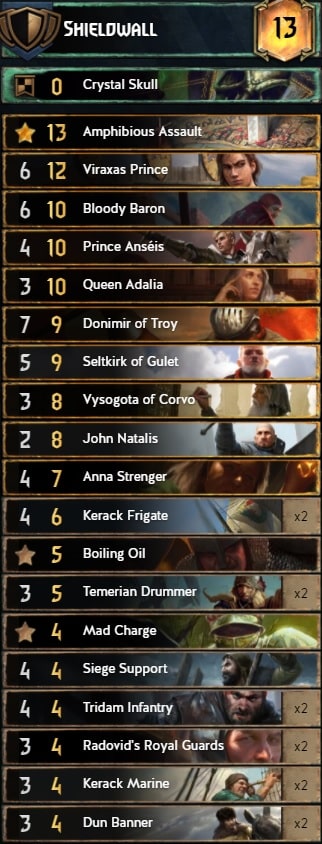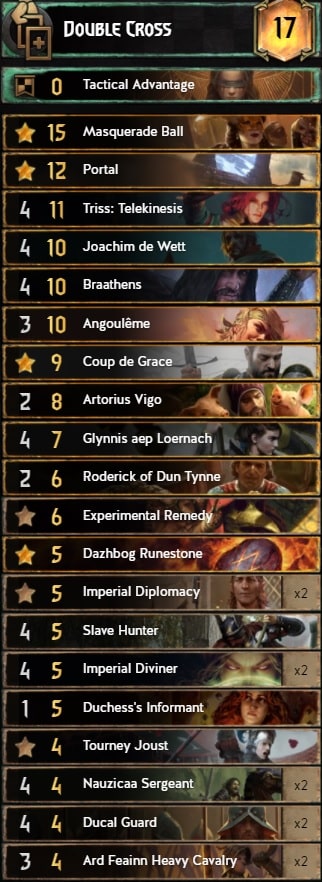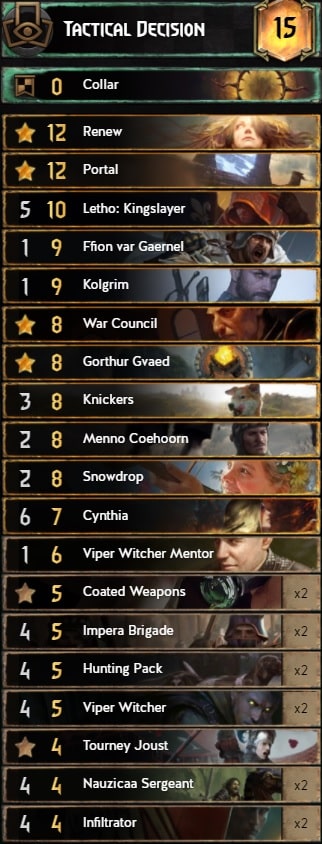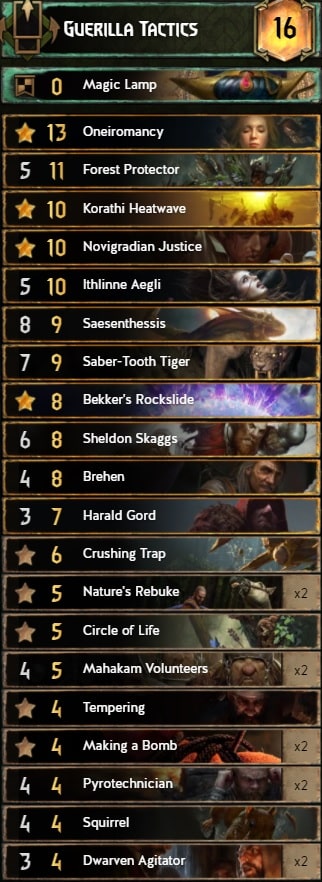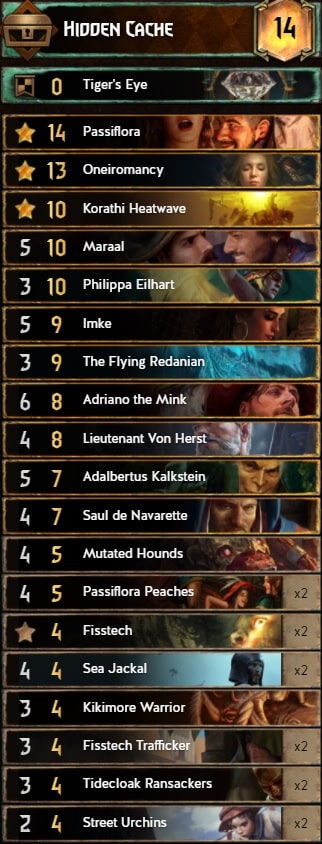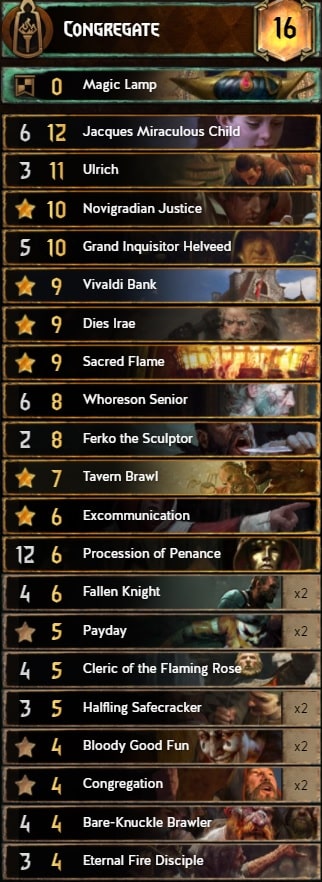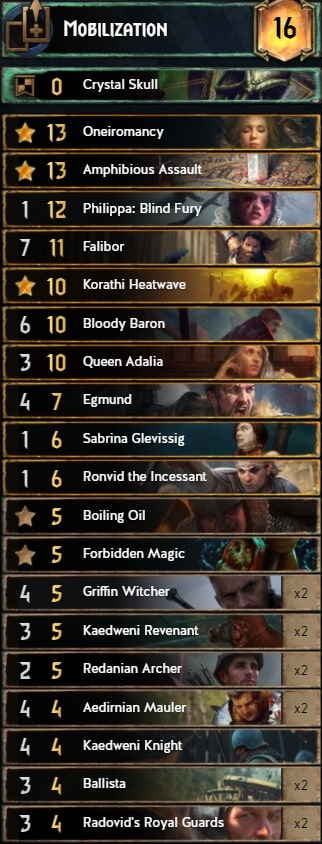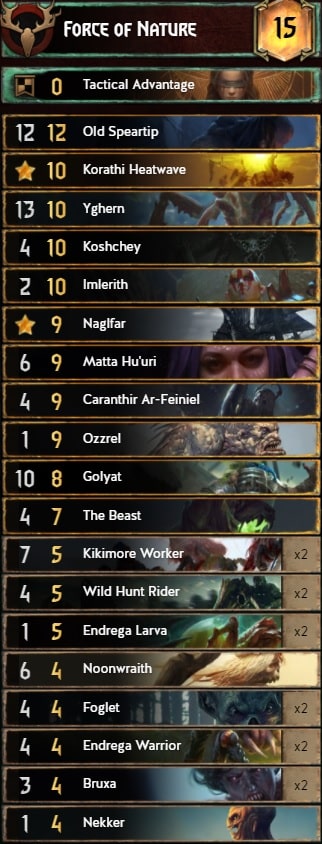Welcome to our 20th meta report! The long-awaited “Way of the Witcher” expansion is upon us, and with it the promised meta shake-up. During the first week, we could witness the birth of Viy, arguably one of the most sophisticated decks in the history of Gwent. Speaking of decks that will challenge your intellect, SK also has some hot candidates, most notably Warriors and Lippy. The new Movement cards have proven to be strong, turning ST into one of the top dogs.
NR can still utilize Shieldwall or Revenants, but Uprising Witchers is now the most effective option. NG has a plethora of decks to choose from. Masquerade Ball is as popular as ever in Lockdown, Double Cross and Enslave decks, but Kolgrim and Assimilate are also viable archetypes. SY got the short end of the stick this patch, which resulted in Congregate and Hidden Cache falling down to the depths of Tier 3.
We will update the report regularly in order to provide the community with a spot-on representation of the current meta. You can join our Discord if you have any questions.
Graphics: WellMax81
Editing: Wusubi, Sebodunum
Writing: Andasama, Avades, BeardyBog, Gravesh, Green-Knight, Jagdulf, KingChezz93, Lorakko, Qnerr, Pajabol, Saber97, SpyroZA, Thekeyer, xCyBerZz

While MO have received many new cards that seemed to be powerful, none have been as dominant as Viy. This has resulted in substantial changes to the Overwhelming Hunger deck we’re used to seeing throughout Master Mirror. With seven tutors and a pair of Foglets for thinning, the deck has unmatched consistency. The inclusion of Ihuarraquax as one of those tutors allows you to remove a deadly Deploy ability from the opponent’s arsenal. Since Viy gets stronger with each consume, the pointslam potential of this deck is impossible to contest, especially in a short Round 3. -Avades
Strengths:
- The deck has one of the best short rounds in the game’s history
- Very consistent, as the game plan revolves around playing as many tutors as possible
Weaknesses:
- You will struggle against engine-overload decks that manage to win Round 1
- Yrden, Lockdown, opponents who limit your consumes with removals and locks while also having several forms of tall punish
Considerations:
- The Beast, Natural Selection

NR Witchers didn’t seem that great in the beginning of last season. Partly because the meta was different and partly because people were playing unoptimized versions. In Round 1, you want to develop your engines with the help of Amphibious Assault, then play Vesemir: Mentor to ensure carry-over for later rounds. If you manage to win Round 1, consider going for an explosive bleed with cards like Keldar, the Witcher thinning trio and Leo to force out the opponent’s win conditions. This makes the list quite flexible, as it also happens to have one of the most powerful long rounds in the game. -Saber97
Strengths:
- Great Round 1 potential with Amphibious Assault and Griffin Witcher Adept, strong on Blue coin with Griffin Witcher + Crystal Skull
- The deck has an insane amount of pointslam, a lot of carry-over and your pay-off cards (Leo, Scytheman) tend to spiral out of control
Weaknesses:
- Vulnerable to tech cards such as Geralt: Yrden
- Having too many Adrenaline cards in your hand can be awkward
Considerations:
- Geralt of Rivia, Prince Anséis
Lippy has been a viable alternative to Warriors for several months by now, and with the “Way of the Witcher” expansion, it got some useful additions in Haern Caduch and Bear Witcher. Moreover, Roach and Knickers are both 1 provision cheaper, making the deck more attractive. Given its straightforward nature, it’s not surprising that Lippy is such a popular deck. You actually do well against MO, as you have access to Korathi Heatwave and Curse of Corruption. -Andasama
Strengths:
- Various big tempo plays in Cerys, Svalblod Totem, Caduch and the Discard package
- Excels at Red coin abuse (as long as you don’t brick too many cards), with a powerful Round 2 bleed and a great Round 3 finisher
Weaknesses:
- Underwhelming in a long round, you get outvalued by engine decks
- The deck has enough bricks to build a house, which makes it very draw dependent
Considerations:
- Tyrggvi Tuirseach, Snowdrop, Stunning Blow, Spores
What would happen if the ST rebels joined forces with the School of the Cat outcasts? “A swarm/engine deck with crazy points” might not be the most lore-friendly answer, but it’s certainly accurate. This deck has a very flexible gameplan, allowing for both engine and pointslam rounds while excelling at both bleeding the opponent and defending the bleed yourself. First, you have to set up your board, then you can start utilizing your control options in Yaevinn, Melee row Vernossiel and Gaetan. -Lorakko
Strengths:
- Great synergy between the cards, your bronze engines effectively protect each other
- Strong in Round 1 with movement engines, with the option of going for a scary bleed using Feign Death and the Elf package
Weaknesses:
- The lack of control can result in getting outvalued in a long round
- Not drawing Feign Death and Oneiromancy can be devastating for your strategy
Considerations:
- You can try out this version with Curse of Corruption
Ignoring the recently introduced Movement cards, the good old Nature’s Gift deck has proven to be decent in the current meta. It still relies on Hamadryad as its core engine - with the help of one leader charge, it will come down at 6 power, allowing you to win Round 1 without committing too many resources. Unlike its predecessors, the deck now includes Geralt of Rivia to deal with the likes of MO and NR Witchers. However, if you see too much SK on ladder, replace Geralt with Figgis Merluzzo. The Defender can protect Pavko Gale, an engine which can quickly take over the game. -Wusubi
Strengths:
- Great presence in Round 1 with bronze engines, Nature cards and Novigradian Justice
- Your Echo cards and several high-tempo plays allow you to bleed your opponent very efficiently while having a big Harald Gord finisher for Round 3
Weaknesses:
- The deck will struggle against SK, as they can easily remove most of your key engines
- Vulnerable to tall punish, missing cards like Oneiromancy and/or Novigradian Justice can be detrimental to your game plan
Considerations:
- Figgis Merluzzo, Circle of Life
As the season progressed, it became clear that Lockdown lacks the juice. The low amount of provisions is a huge issue against powerhouses like NR Witchers. Luckily enough, the deck can adapt to the meta by switching its leader ability to Double Cross while upgrading one of its bronzes to Leo Bonhart. That way, the matchup against Viy is still very favored. A well-timed use of Double Cross can be great - you get a solid card that procs your Assimilate engines. It also puts your opponent in a weird spot. They either have to sequence suboptimally and lose value or accept the fact that you can play one of their big golds. -Wusubi
Strengths:
- Ramon Tyrconnel and Braathens are as strong as ever, allowing you to either contest Round 1 or defend the bleed with ease
- With Poison, Leo Bonhart, Invocation and the bronze locks, you have a lot of efficient answers for tall units and engines alike
Weaknesses:
- Struggles against swarm decks like Deadeye Ambush
- With different packages being included, you could end up with a dysfunctional hand
Considerations:
- You can try out this version with Lockdown
Ciri: Nova has always been considered a meme card, but now she finally found her place in the deck manipulation archetype. Most of the cards you want to run don’t cost more than 9 provisions, so the deck-building restriction isn’t a big deal. Ciri: Nova can be strong in many situations. For example, you can use her to tempo ahead deep into Round 1, forcing your opponent to either lose on even or take the round down a card and then be down 8 points in Round 2. The deck also includes Hefty Helge with Tactics, massive Viper Witcher Mentors and Kolgrim that can play for 10+ points per turn. -Saber97
Strengths:
- Great removal tools in Hefty Helge and the Tactics package, along with big finishers in Viper Witcher Mentors and Kolgrim
- The deck can win on even due to the extra tempo from Roach and Knickers, and it also punishes the opponent for having a bad hand in Round 1 by reducing their odds of ever finding their high-end golds
Weaknesses:
- You don’t have any tall punish or locks, so it’s very difficult to beat a deck like Carapace
- If your opponent draws most of their golds and/or tutors like Oneiromancy in Round 1, the deck-clogging aspect of this deck will lose a lot of its power
Considerations:
- Assassination, Spores
While the game plan of the deck remains as straightforward as it is complex, the shift in the meta towards more engine-based and less control-oriented decks make this threat-heavy version more appealing as a ladder option. As usual, abuse Ciri: Dash in Round 1 if possible and try to force the opponent’s huge answers such as Korathi Heatwave with some of your threats to enable your other top-end cards to ultimately take over the game. -Gravesh
Strengths:
- Preys on decks that have a limited amount of control tools
- Keltullis and Ciri: Dash combined with efficient removal allow for various ways to take over games, even in a bad matchup
Weaknesses:
- If your big threats get answered, the whole deck falls apart
- Although some of its binary matchups make it look otherwise, the deck is incredibly difficult to pilot to its full potential
Considerations:
- Alzur’s Thunder, Noonwraith
If you still enjoy playing SK Warriors you’re in luck, because the archetype is here to stay. The new expansion brought in some decent pointslam additions in Haern Caduch and Bear Witcher, making your Round 1 presence even scarier. The switch from Patricidal Fury to Ursine Ritual grants you 2 more provisions and also allows you to utilize Cerys an Craite and Blueboy Lugos. The core gameplay is still the same though - gain round control with your bronze engines and overpower the opponent with your tempo and control options in later rounds. -xCyBerZz
Strengths:
- Vabjorn and Blood Eagle make the deck fairly consistent
- With good bronzes and reliable control tools, you have a flexible game plan
Weaknesses:
- Very unfavored against Monsters (Carapace and Viy)
- Sometimes you’ll have a weird hand in Round 1, which can force you to pass
Considerations:
- Tyrggvi Tuirseach, Herkja
Battle Trance is finally back in the meta, serving as a flexible pointslam deck. So, what has changed with the recent expansion? The introduction of Bear Witcher Adept allows you to cut the Discard package and play Portal instead. Haern Caduch is a great tempo addition and Oneiromancy made its way back into the deck as a much-needed tutor. Fight for round control using your engines and pointslam cards, then go for a soft bleed with the Crowmother carry-over, forcing a short Round 3 with Gedyneith. Even if you fail to win Round 1, the deck is great at defending the bleed and can usually hold its own in a long round. -Wusubi
Strengths:
- The deck has a crazy finisher with Gedyneith, Crowmother and Crow Clan Preachers
- Portal into Bear Witcher Adepts serves as both a high tempo play and a way to thin your deck, also providing a decent “sponge” for Svalblod Priest
Weaknesses:
- You have a limited amount of control tools, which can result in getting outvalued by engine-overload decks
- Portal and Crow Messengers make your mulligans a bit tricky, missing Oneiromancy and/or Gedyneith can be detrimental to your game plan
Considerations:
- Svalblod Totem, Mardroeme
The control-heavy version of Precision Strike still has its place in the meta with some engine decks running around, while triple tall punish helps against Viy. The introduction of Saber-Tooth Tiger in combination with Madoc and the Bomb package makes the deck more competitive on Blue coin, as it’s hard for your opponent to get any board pressence in Round 1. However, it also takes away your flexibility, as Schirrú is impossible to fit into this deck if the meta gets more swarm-oriented. -KingChezz
Strengths:
- Has multiple forms of tall punish to deal with decks like Carapace, Viy, NG with double Joachim and even NR Witchers
- Can shut down pretty much any form of an engine deck, while making life extremely difficult for other control decks due to its very limited amount of units
Weaknesses:
- Unfavored vs pointslam decks like Lippy (low amount of points on your own side of the board and removal won’t find too much value)
- If you don’t have the last say in Round 3, you can struggle with finding proactive plays and Harald Gord will usually get answered by a tall punish
Considerations:
- Tempering, Squirrel
Enslave has yet again found its way into the meta. As usual, this is in order to keep the engine friends in check. Despite getting a few new interesting toys to experiment with thanks to the recent expansion, NG can arguably still rely on its evergreens in this mix of Tactics and poison-soaked intrigues. Coated Weapons nicely supplements long-established bronzes in this category like Assassination, but it also comes with a drawback - for instance, you should think twice before using it on a gold card. -Jagdulf
Strengths:
- A wide range of control tools and a sufficient amount of tall punish
- Excels at Red coin abuse, Tactics can be annoying due to their non-interactive nature
Weaknesses:
- Can struggle with proactivity
- The deck runs multiple packages, making it both difficult to pilot and draw dependent
Considerations:
- Braathens, Duchess’s Informant
As usual, a new expansion equals the arrival of a myriad of new decks, as well as a heavy meta shift. Right? Well, some decks are so strong that they just don’t care at all. While not seeing much play at the moment due to everyone playing around with what the expansion had to offer, there is no doubt that Shieldwall will rise once players shift their focus on climbing the ranks again. There is not much else to say about this deck - you’ve most likely seen it more than enough already. -Gravesh
Strengths:
- Favorable matchup against Viy, which is one of the most popular decks on ladder
- Amphibious Assault, triple Duel with Anséis, Seltkirk and Viraxas, powerful engines, you name it
Weaknesses:
- Control decks like Enslave and Precision Strike
- You don’t have a tutor for your high-end cards, which can lead to disappointing losses
Considerations:
- Falibor, Griffin Witcher

While the core concept of Assimilate remains mostly the same, some of its old toys perform even better after their rework/buff, namely Portal and Braathens. Moreover, with the introduction of location cards and many of the meta decks utilizing artifacts, Angoulême is a very scary card when combined with all the Assimilate value. This deck still does what it has always done well, which is to have a powerful long round while also having some high tempo cards to help with defending the bleed. -SpyroZA
Strengths:
- Flexible game plan with great long round potential
- You have the ability to use your opponent’s strategy against them
Weaknesses:
- Very limited control options
- With only two Aristocrats (and Coup de Grace), Masquerade Ball can be a bit awkward
Considerations:
- Angoulême, Tourney Joust → Yennefer’s Invocation, Slave Hunter
While hyperthin NG always had a place in our hearts, the “Way of the Witcher” expansion introduced some cards and changes which have improved this archetype. These include a solid finisher in Kolgrim and provision buffs to Portal, Nauzicaa Sergeant and Knickers. You can pollute the opponent’s draws using Cynthia, Infiltrator, Coated Weapons and Viper Witcher. This means that even if your opponent runs a tall punish, they might not draw it unless they already found their tutor in Round 1. -Beardy
Strengths:
- Strong presence in Round 1 with Portal, Knickers and the bronze thinning cards
- Bricking your opponent’s draws for the future rounds makes for great Red coin abuse, with a strong pay-off card in Kolgrim
Weaknesses:
- Susceptible to tall punish, the lack of control tools means that engine-overload decks can try to 2:0 you
- The deck has a predictable game plan and relies on winning Round 1, besides if your opponent finds most of their golds in Round 1, your strategy falls apart
Considerations:
- Roach, Alba Armored Cavalry
When the ladder does you dirty, it’s time to whip out the secret Guerilla Tactics. Much like the control version of Precision Strike from the past, this list combines control and carry-over with non-interactive units such as Saesenthessis and Saber-Tooth Tiger. The main goal of the leader is to ensure guaranteed value from cards like Brehen. While this definitely isn’t the best take on ST, seeing your opponent discard half of their hand in Round 3 can be very satisfying. -Gravesh
Strengths:
- Strong Red coin abuse with carry-over and a few high-tempo plays
- The very low amount of units combined with a control-oriented game plan counters some top meta decks like Lockdown and Patricidal Fury
Weaknesses:
- A lack of points overall, especially problematic on Blue coin
- Even with all the synergies, Guerilla Tactics remains a rather weak leader ability
Considerations:
- Geralt of Rivia, Alzur’s Thunder
SY hasn’t received anything good this expansion, making it simultaneously the least popular and most underestimated faction. In the current meta where winning Round 1 is crucial, Hidden Cache performs surprisingly well. Strong engines like Saul, Imke or even Kikimore Warrior can grant you round control without too much commitment. Philippa Eilhart and the poison package allow you to control the opponent’s board. Passiflora offers a lot of points, making for a great Round 2 bleed if needed. -Qnerr
Strengths:
- The deck has a lot of powerful engines that can secure Round 1
- Philippa Eilhart can often tip the scales in your favor; stealing cards like Cerys an Craite or Gezras is obviously incredibly strong
Weaknesses:
- The popularity of Lockdown and Precision Strike is a serious issue
- As usual, SY as a faction has a very steep learning curve and is difficult to master
Considerations:
- Jacques Miraculous Child, Azar, Sewer Raiders, Squirrel
Although the deck hasn’t received any additional tools in the newest expansion, Firesworn can still produce an insane amount of points in a long round, taking the opponents by surprise if they aren’t careful. That being said, the meta has shifted in a way that all of the dominant decks also happen to be a poor matchup for Congregate. In addition, Yrden seems to be a commonly used tech card these days, which is a big issue. -Thekeyer
Strengths:
- Absurd long round potential, with solid short round plays like Jacques
- Vivaldi Bank and Ferko make the deck fairly consistent at finding its win conditions
Weaknesses:
- Extremely difficult to pilot, lack of reliable control tools
- You can end up with broken packages if your opponent bleeds you in a smart way
Considerations:
- Smuggle, Mutants Maker
The new expansion has introduced many new archetypes, but it also provided some efficient tools for the already-existing ones. This is most certainly the case for Revenants, which gladly incorporated the Griffin Witcher into the Kaedweni army of spectres. Being a both a control and an engine-overload deck due to Mobilization, it offers a rather unique playstyle. You’re free to adjust to the opponent’s strategy, which makes this list a good choice for players who feel like they know the meta well. -Lorakko
Strengths:
- Lots of damage engines that can heavily snowball when uninterrupted, which makes for a great long Round 3
- You can punish the opponent for going wide as well as for going tall, which gives you a win condition against multiple archetypes
Weaknesses:
- Unfavored matchup against other control decks, e. g. Precision Strike
- Somewhat draw dependent, defending the bleed in Round 2 can be awkward if you don’t find Amphibious Assault
Considerations:
- Curse of Corruption, Squirrel
The expansion brought support for big boys and the Thrive package with the Koshchey card, offering an obvious synergy with Force of Nature as well. Matta can be used to cheat the Adrenaline mechanic and have an extra Larva-spawning turn. Despite having a lot of points, the deck has a linear game plan - experienced players should be able to abuse it. For example, removing Koshchey or moving units around can end up costing you a serious amount of points. -Thekeyer
Strengths:
- The deck is easy to pilot
- Explosive in a short Round 3, the deck can do 50+ points in 4 cards
Weaknesses:
- Korathi Heatwave is your only source of removal
- Even though the deck includes Naglfar and Matta, it’s still fairly draw dependent
Considerations:
- Heatwave, Kikimore Worker → Geralt: Yrden, Squirrel

